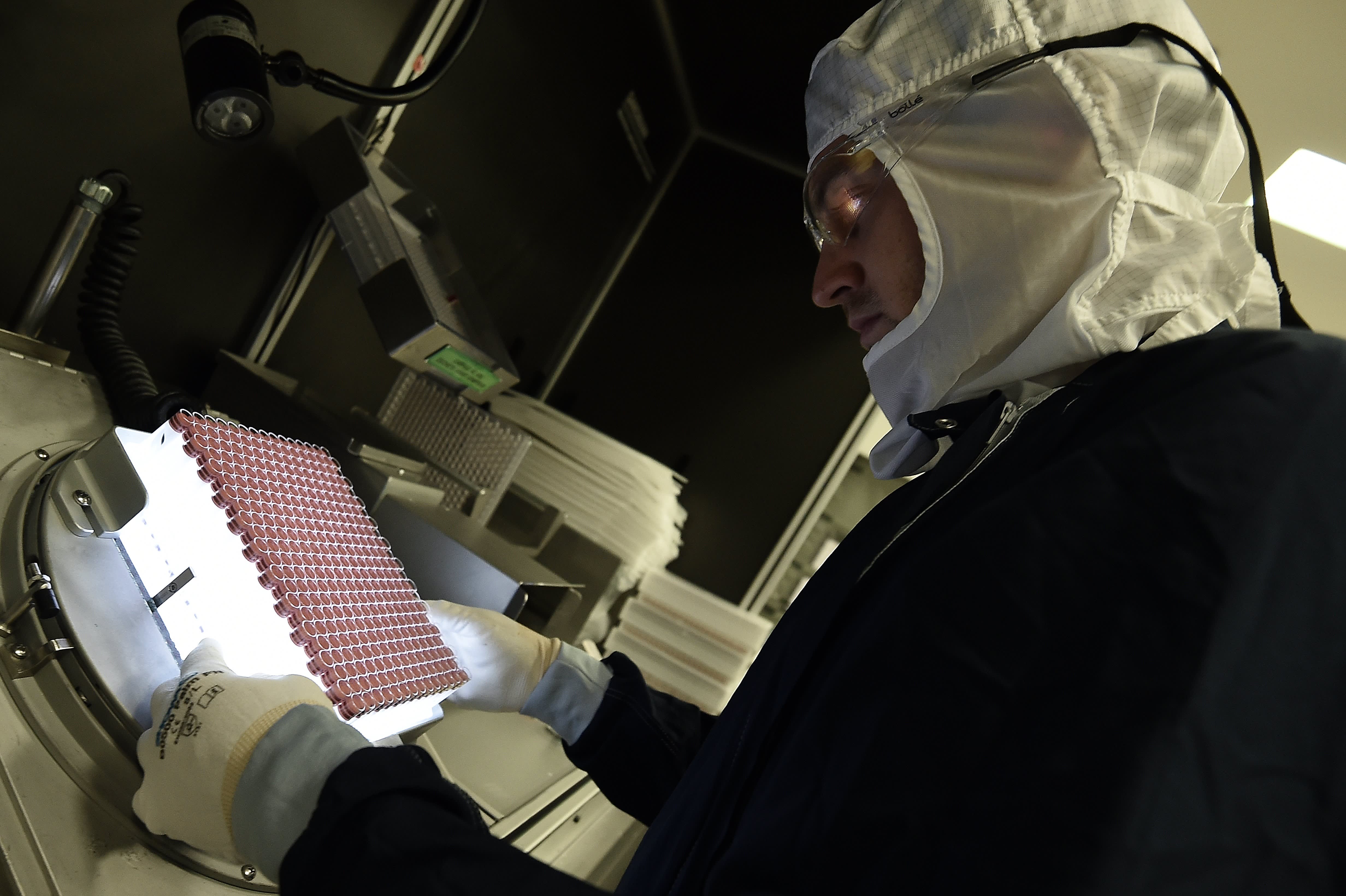
There’s Eli Lilly (LLY), and then there’s everybody else. That’s a simple way to describe the performance of the Club’s health-care holdings so far this year, in what’s been a challenging period for the industry overall. Of the 11 market sectors year to date, health care is the fourth worth-worst performer, falling 4%, followed by consumer staples (down 4.2%), real estate (down 5.8%) and utilities (down 10%). Our standout is unquestionably Eli Lilly, which has soared 50% in 2023 on the promise of its experimental weight-loss and Alzheimer’s drugs, making it the most-valuable health-care company in the world. Lilly’s run really started in last year’s terrible market, soaring more than 30% compared to the S & P 500’s nearly 19.5% plunge in 2022. That’s a nearly two-year return of almost 100%. LLY XLV YTD mountain Eli Lilly’s year-to-date stock performance compared with the XLV, a major ETF that tracks the health-care sector. Lilly’s shadow looms large over the likes of GE Healthcare (GEHC), Humana (HUM) and Danaher (DHR) —three companies whose futures remain bright, but whose stocks have nonetheless been drags on our portfolio this year for reasons that include post-Covid pandemic normalization. Bausch Health (BHC) is a different case. While bouncing more than 30% in 2023, shares of the troubled Canadian pharmaceutical firm had a brutal 2022 — and, for now, remain stuck in the legal mud. Its stock price is about a third of what it was less than two years ago. The health-care sector ‘s underperformance in 2023 can be chalked up to a variety of factors — among them its relative success last year, when it fell less than 4% compared with the broader S & P 500, which had its worst year since 2008. In 2022, as Federal Reserve commenced an aggressive interest-rate-hiking campaign to try to slow down red-hot inflation, health care benefited from its limited sensitivity to swing in the economy. That defensive trade, however, lost its luster in 2023, as concerns subsided about an around-the-corner recession and investors began anticipating the end of the Fed’s tightening cycle. Add in the artificial intelligence optimism, and the conditions were ripe for investors to buy last year’s losers — such as technology stocks and other economically sensitive sectors — and take profits in their relative winners, like health care. “That helps to explain a big portion of the reversal we’ve seen this year” in the health-care sector, said Ryan Issakainen, an exchange-traded fund strategist at First Trust Advisors, which has a health-care ETF . Key points Health-care stocks outperformed the broader U.S. stock market last year, but this year it’s been much-tougher sledding for the sector due to a variety of headwinds. Eli Lilly has been the best-performing Club health care stock by a substantial margin, driven optimism around its experimental weight loss and Alzheimer’s drugs. We feel comfortable owning our three other primary health care stocks: GE Healthcare, Humana and Danaher. After this sector-level rotation emerged early in the year , individual corners of the health-care industry have also contended with their own mix of storm clouds. For example, the Inflation Reduction Act of 2022 weighed on the stocks of pharmaceutical companies whose drugs might be selected for Medicare’s new price-negotiation program , which kicks in 2026. That uncertainty lingered until late August, when the agency that runs Medicare announced the 10 chosen drugs. “Even if we’re not talking about the individual impact on revenue for individual pharmaceutical companies, there’s a sentiment overhang that also impacts the sector as these sorts of provisions become a reality,” Issakainen said. “It impacts investor psychology and sentiment, as well.” One of Eli Lilly’s type-2 diabetes treatments, Jardiance, was selected . However, the drug isn’t a primary reason for bullishness on the company’s long-term prospects. Favorable developments around Alzheimer’s and weight-loss drugs carried more importance for its stock price and our investment thesis. For Danaher and its peers that sell products, tools and services used in the drug development process, business this year has been impacted by pandemic-related inventory build-ups and a slowdown in biotechnology activity, especially in China. The latter factor, in particular, has worsened lately and contributed to Danaher in July cutting its full-year sales growth outlook for the second time this year. A regulatory decision on Medicare Advantage overpayments was among the early hurdles for managed care stocks — which includes the likes of Humana and Dow stock UnitedHealth Group (UNH) – then months later, in mid-June, the group got slammed again on concerns about rising medical costs, as patients started getting procedures that had been put off during Covid. The other side of that coin, though, is medical-technology companies such as GE Healthcare, orthopedic device maker Stryker (SYK) and Steris (STE), which sells surgical instruments and sterilization equipment. The increase in procedures and improved staffing in hospitals has benefited these companies, making their stocks relatively strong performers compared with the health-care sector overall. Indeed, the health-care equipment and supplies industry index — home to GE Healthcare and the other two — has fallen only 1% so far this year. Shares of GE Healthcare have outperformed, with a 9.4% year-to-date gain. Considering all the industry crosscurrents, we feel comfortable with our health-care exposure (with BHC as a question mark), particularly after locking in substantial profits on part of our Eli Lilly position last week. Simply put, Eli Lilly’s magnificent run this year prompted our discipline to kick in despite remaining confidence in its growth prospects driven by its type-2 diabetes drug Mounjaro , which could see U.S. regulator approval for weight-loss later this year, and its Alzheimer’s treatment , which may be approved by regulators before year-end. “Now we have room … to buy it if something short-term goes wrong that we don’t think is that horrible,” Jim Cramer added Thursday during the September edition of the Club’s Monthly Meeting. DHR YTD mountain Danaher year-to-date stock performance. Danaher’s stock has been a major disappointment — though it’s now down 6% for the year, at $249.63 per share, after a solid move off its 2023 closing low of $224.99, on May 16. Additional gains should be ahead because the thawing IPO market will help some of Danaher’s biotech customers to go public, receiving an influx of capital to invest in drug development – which, by extension, means orders for its equipment. Additionally, its planned acquisition of antibody maker Abcam and soon-to-be-completed Veralto spin-off improve the company’s growth profile going forward. “A positive is re-rating is about to occur for Danaher,” Jim argued. “We are on the cusp of it. Buy Danaher.” HUM YTD mountain Humana year-to-date stock performance. Similar to Danaher, the damage in Humana has improved lately, and bailing on our position at the stock’s current valuation around 15 times forward earnings doesn’t seem like the best path forward. Fortunately, the stock has advanced more than 16% off its mid-July bottom, but it’s not fully recovered from the June sell-off on utilization concerns. Humana’s shareholder-friendly management team and its fast-growing Medicare Advantage offering are reasons to stick around. GEHC YTD mountain GE Healthcare’s year-to-date stock performance. GE Healthcare is quagmire. For the year, the return on shares of the medical imaging and diagnostics are respectable. The issue is all of its gains came between January — when it was officially separated from General Electric (GE) — and late April, with a closing high of $87.79 per share. Then it began to pull back, which gave us a chance to initiate our position May 17 , at around $79 per share. The stock has since retreated further — to current levels around $64 per share. “What are the sellers thinking? I don’t know,” Jim said during the Monthly Meeting. “They’re wrong.” We’ve been buying on the way down, most recently on Sept. 5 , because our reasons for owning the company in the first place remain intact. Those reasons include its opportunity to benefit from the rollout of Alzheimer’s drugs that target abnormal clumps of a protein called amyloid beta on patients’ brain. Taking these drugs – specifically, the already-approved Leqembi from Biogen and Lilly’s donanemab – requires patients to undergo multiple brain scans in MRI machines, which GE Healthcare makes. GE Healthcare also makes PET scanners and a diagnostic agent called Vizamyl that, together, can help measure levels of amyloid beta on the brain. Amyloid has long been linked to Alzheimer’s disease. In recent weeks, analysts at Wells Fargo and Citigroup have started coverage of GE Healthcare with buy ratings. Both called out the company’s range of products to support Alzheimer’s detection and treatment. BHC 5Y mountain Bausch Health 5-year performance. Bausch Health’s stock gains throughout the year haven’t been enough for the company to leave our penalty box. And on Monday it announced its CFO resigned to pursue an opportunity at another company. But on Wednesday BHC received an upgrade from investment bank Jefferies. We’re not there yet – our 4 rating on BHC remains – but it’s nevertheless a notable call. The analysts at Jefferies now rate Bausch Health stock a buy, with a price target increase to $16 per share from $9. That would be about a double from current levels. However, as we pointed out earlier, even at $16 the stock would still need to more than double again to reach 2021 highs of $34.38. “I’m not saying buying it. I’m simply saying we aren’t sellers for the moment,” Jim said Thursday. Jefferies expressed optimism around the company’s ability to surmount its legal challenges involving the patent for its key drug Xifaxan. With that hurdle cleared, BHC’s path to further monetize its nearly 90% stake in Bausch + Lomb (BLCO) would become “more defined,” Jefferies wrote. While BHC’s divestiture of eye-care unit Bausch + Lomb has veered way off script, Jefferies sees a higher probability that Bausch Health can unlock more value from BLCO. (Jim Cramer’s Charitable Trust is long LLY, GEHC, HUM, DHR and BHC. See here for a full list of the stocks.) As a subscriber to the CNBC Investing Club with Jim Cramer, you will receive a trade alert before Jim makes a trade. Jim waits 45 minutes after sending a trade alert before buying or selling a stock in his charitable trust’s portfolio. If Jim has talked about a stock on CNBC TV, he waits 72 hours after issuing the trade alert before executing the trade. THE ABOVE INVESTING CLUB INFORMATION IS SUBJECT TO OUR TERMS AND CONDITIONS AND PRIVACY POLICY , TOGETHER WITH OUR DISCLAIMER . NO FIDUCIARY OBLIGATION OR DUTY EXISTS, OR IS CREATED, BY VIRTUE OF YOUR RECEIPT OF ANY INFORMATION PROVIDED IN CONNECTION WITH THE INVESTING CLUB. NO SPECIFIC OUTCOME OR PROFIT IS GUARANTEED.
An employee works in an unit dedicated to the production of insulin pens at the factory of the US pharmaceutical company Eli Lilly in Fegersheim, eastern France.
Frederick Florin | AFP | Getty Images
There’s Eli Lilly (LLY), and then there’s everybody else.
This article was originally published on CNBC

